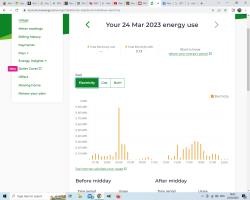Korishan
Administrator
- Joined
- Jan 7, 2017
- Messages
- 7,538
Well, not totally. Because what if for the hour you used 15kWh. However, in the first 15mins you used 70% of that and the subsequent 45mins the heater just idled keeping the temp stable.So every 15 minutes, I'd be using the same power, but only 1/4 of the energy.
So in this situation you had a surge of energy usage of 12,750 Watts. At 240V that's 54A
So yup. You got it here.Now, during that 15 minutes, the power could certainly have gone lower or higher. But the average would still work out to 15kW and 3.75kWh. Not an instantaneous measurement of peak Watts or Amps
The reason I bring this up is because you need to also consider the "surge" periods. So with the above, if your furnace is pulling 54A currently, and you happen to turn on the electric stove (assuming you have one), then that could cause another spike that could push you into red zone.
What I would actually recommend here is getting something like an Iotta Watt or an Emporia unit. The Emporia is actually *very* well priced. For <$150 you can get 2 mains clamps with 8 circuit clamps.I suppose what I aught to do is get one of those clamp meters with data logging. Something that would give me actual Amps and could measure a maximum peak.
The added bonus is that this unit can be reflashed with ESPHome energy monitoring to get rid of the cloud management portion (and giving data to the parent company).
You can upgrade the mains clamps to a higher rating if you need to. They also make a 3-phase version if you plan on doing that in the future.
Yeah, sounds like they labeled them backwards. Good thing you've checked before getting your fingers in where there might be live wires.The breaker labeled "blower" uses 42.5A. I think that's actually the element circuit. The other breaker labeled "furnace" uses 20A. I think that one is actually the blower circuit. I'm not sure if that's enough to calculate the BTU of the furnace. I also don't know if I'd need the same BTU for a heat pump.
BTU's are BTU's. So if you have similarly rated heat pump, then the same heat will be produced. The difference is that the heat pump would, should, use a lot less power to create that heat.
*side note: I haven't read all of your previous postings in detail, so I may have overlooked some details. If so, please be kind in the corrections



